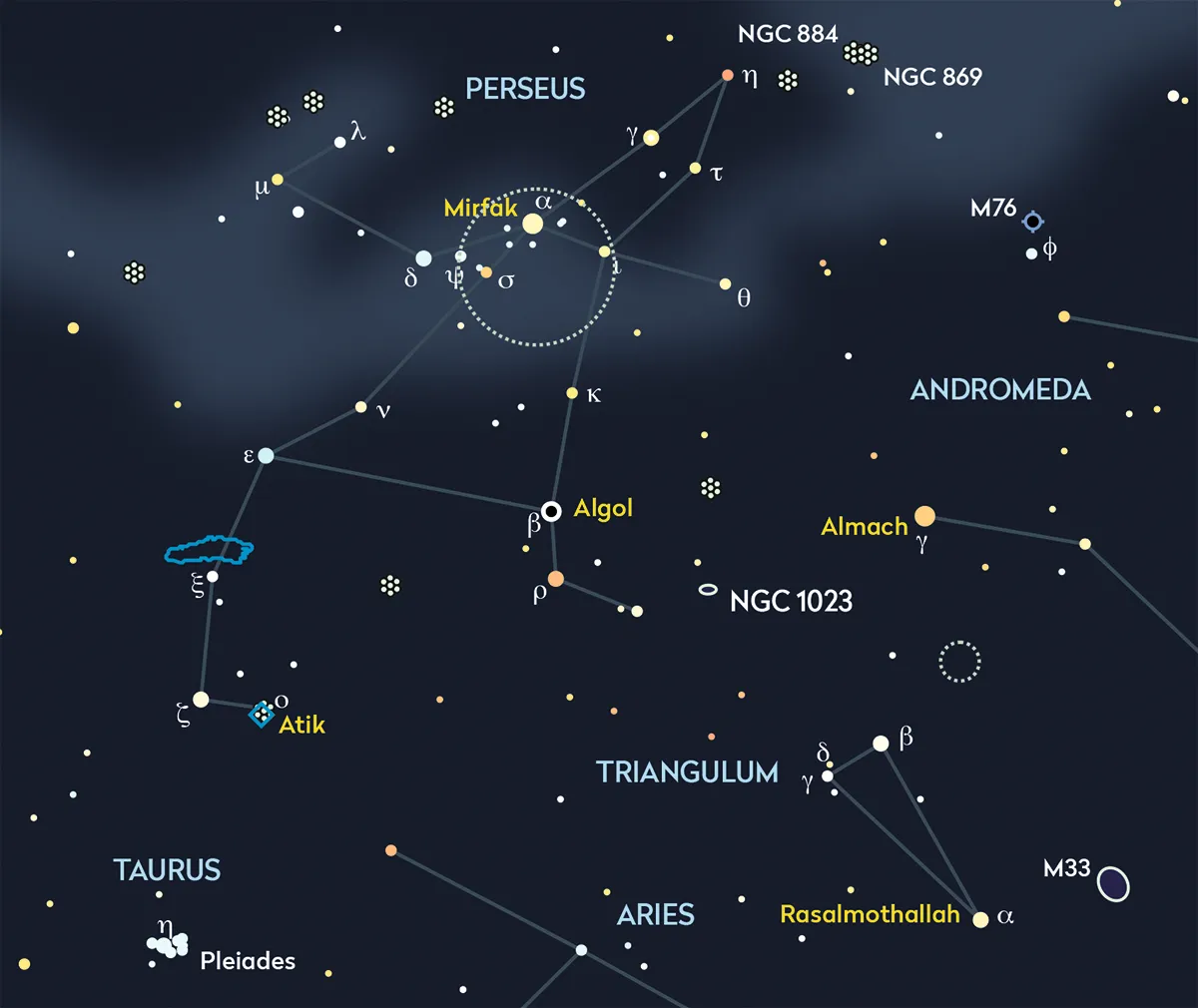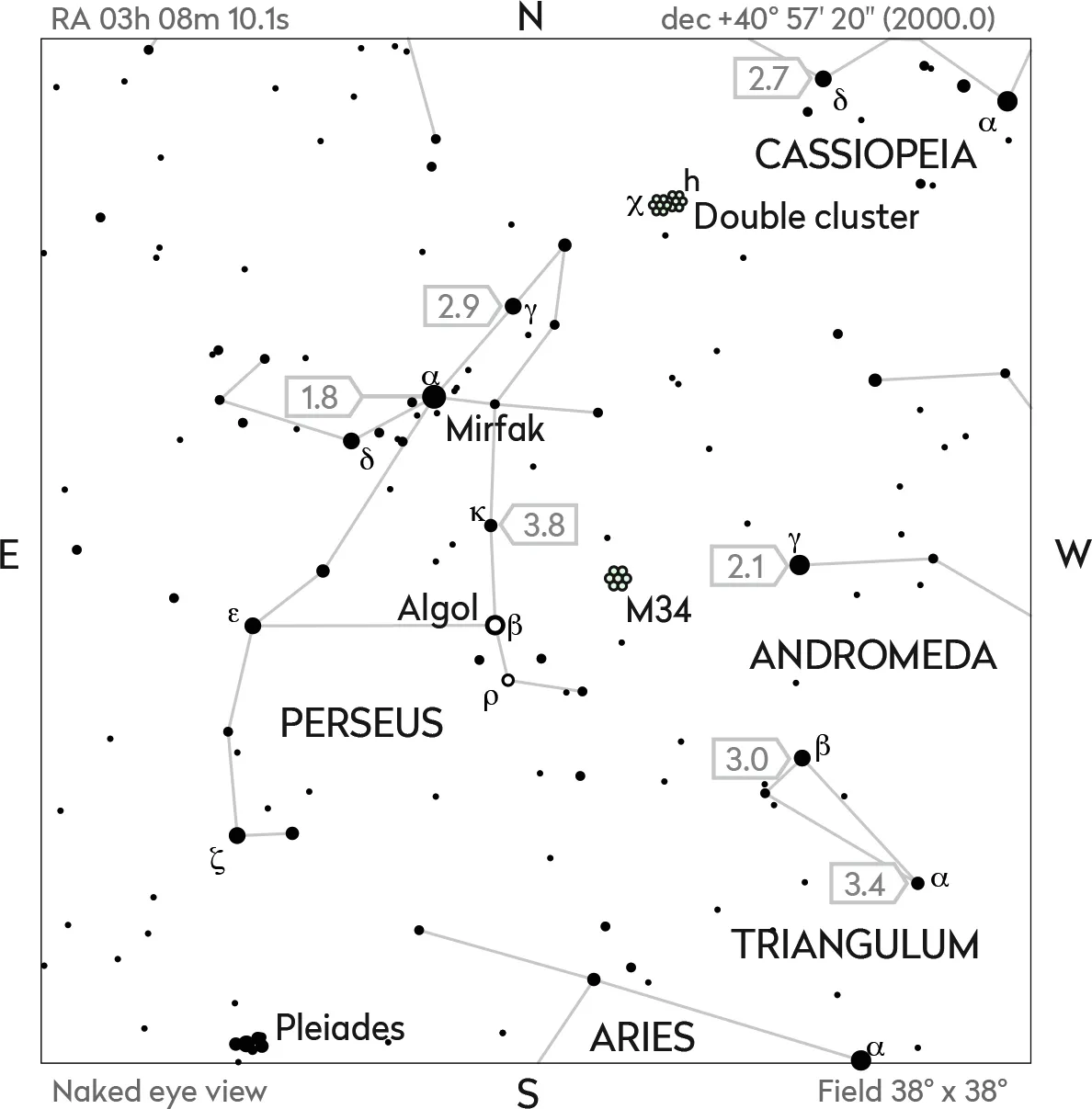Ask any astronomer to name the most famous variable star in the sky and many will say Algol, the eclipsing binary in Perseus whose variations were first reported in 1670 by the Italian astronomer Geminiano Montanari.
Algol the 'Demon Star' is clearly visible in the evening throughout winter, dropping to one-third of its usual brightness every 2.87 days for 10 hours as it is partially eclipsed by a fainter companion before returning to normal.
Ask that same astronomer what Algol represents and the answer is likely to be ‘the winking eye of Medusa’, the Gorgon slain by the Greek hero Perseus in one of the most famous stories of ancient mythology. But is this true?

Chart showing the location of star Algol in Perseus
The mythology surrounding star Algol
To explore star Algol's mythology, let’s go back to the star catalogue compiled by the ancient Greek astronomer Ptolemy in his book the Almagest, written around the year AD 150.
Ptolemy’s catalogue contained over 1,000 naked-eye stars arranged into 48 constellations based on mythical characters and legendary beasts.
It’s the basis for our present-day layout of the sky.
Ptolemy listed 26 stars in Perseus and described how they could be used to create an outline of the flying hero’s body: his winged feet, the left hand grasping Medusa’s snake-haired head and the right hand brandishing the blood-spattered sword with which he had decapitated her.
Four of those stars, according to Ptolemy, lay in the head of Medusa.
The star we now know as Algol (an Arabic name that came long after Ptolemy’s time) he called “the bright one in the Gorgon’s head”.
The head, notice. No mention of an eye.

Algol and the Almagest
The Almagest contained no star charts.
The first illustrated version of the Almagest was produced by the Arab astronomer al-Sūfī (better known by the Latinised version of his name, Azophi) over 800 years after the Almagest was written.
Al-Sūfī’s Book of the Fixed Stars, published around the year AD 964, adopted the same 48 constellations recognised by Ptolemy, but featured hand-drawn illustrations.
Still long before the days of printing, these often varied from copy to copy.
What is reputedly the oldest surviving example of al-Sūfī’s book, dated to around AD 1010, visualises Perseus clad in Arabic robes.

On this illustration the head of Medusa has become that of a man with a beard, possibly due to the illustrator seeing depictions in which the Gorgon’s dangling snake-hair gave the impression of long whiskers.
Algol is the largest of four stars in the head and, crucially, it is placed next to Medusa’s eye, not on it.

Chart showing the location of star Algol
Algol's etymology
Ptolemy did not give a name for Algol, but the Arabs did. They called it ra’s al-ghūl, ‘the demon’s head’, from which comes our word Algol, meaning demon or ghoul.
It is sometimes suggested that the ghoulish reference arose because Arab astronomers knew of its variability, but al-Sūfī made no mention of any such variability, despite the fact that he paid particular attention to star brightnesses and corrected many of the magnitudes assigned by Ptolemy.
By calling this star ra’s al-ghūl, al-Sūfī and his fellow astronomers were simply translating Ptolemy’s description in the Almagest.
They did not see it as Medusa’s eye at all.
Taking all this evidence together, it is clear that there is no evidence that the variability of Algol was known before Montanari announced it in the 17th century.
Rather, it seems that the name Algol has its origins in Greek mythology and the star’s variability is simply coincidental.
The idea of Algol being a ‘winking eye’ is a modern myth.
Algol as a variable star

It would take six centuries for western astronomers to make note of star Algol after al-Sūfī’s observations, and none of these early depictions showed it as Medusa’s eye.
In 1603, German astronomer Johann Bayer published his star atlas Uranometria, labelling Algol as Beta Persei.
On his illustrated chart of Perseus, Bayer followed al-Sūfī’s portrayal, placing Algol on Medusa’s temple next to her right eye, and not on it (see image above).
The first astronomer recorded as noting Algol’s variability was Montanari in 1670.
It was only the second-known variable star, 30 years after the brightness of Mira in Cetus was found to also fluctuate.

However, it seems that initially this fact was either not known or not accepted, as when John Flamsteed, the first British Astronomer Royal, created his star atlas, Atlas Coelestis, in 1729, he made no acknowledgment of its variability.
He simply listed Algol as a second-magnitude star. He also placed it even higher on Medusa’s forehead than previous depictions.

The variability of Algol, it seems, was lost for many years, until it was rediscovered and explained by the teenage prodigy John Goodricke over half a century later.
The next great atlas to be published after this second announcement was Johann Bode’s Uranographia of 1801.
Bode labelled the star "variabilis", but he still drew it on the top of Medusa’s head, not on her eye.

